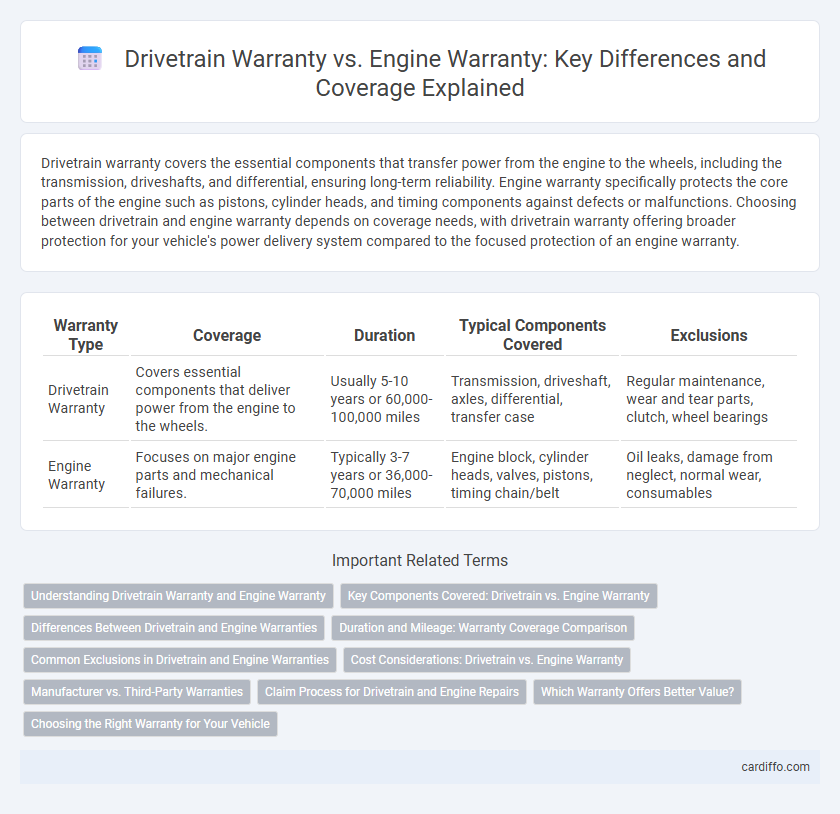Drivetrain warranty covers the essential components that transfer power from the engine to the wheels, including the transmission, driveshafts, and differential, ensuring long-term reliability. Engine warranty specifically protects the core parts of the engine such as pistons, cylinder heads, and timing components against defects or malfunctions. Choosing between drivetrain and engine warranty depends on coverage needs, with drivetrain warranty offering broader protection for your vehicle's power delivery system compared to the focused protection of an engine warranty.
Table of Comparison
| Warranty Type | Coverage | Duration | Typical Components Covered | Exclusions |
|---|---|---|---|---|
| Drivetrain Warranty | Covers essential components that deliver power from the engine to the wheels. | Usually 5-10 years or 60,000-100,000 miles | Transmission, driveshaft, axles, differential, transfer case | Regular maintenance, wear and tear parts, clutch, wheel bearings |
| Engine Warranty | Focuses on major engine parts and mechanical failures. | Typically 3-7 years or 36,000-70,000 miles | Engine block, cylinder heads, valves, pistons, timing chain/belt | Oil leaks, damage from neglect, normal wear, consumables |
Understanding Drivetrain Warranty and Engine Warranty
Drivetrain warranty covers critical components that deliver power from the engine to the wheels, including the transmission, driveshaft, and differential, ensuring protection against mechanical failures in these parts. Engine warranty specifically safeguards the engine itself, covering repairs or replacements of key elements like pistons, valves, and cylinder heads due to defects or malfunctions. Understanding the distinctions between drivetrain and engine warranties helps vehicle owners identify the scope of coverage, optimize maintenance, and reduce unexpected repair costs.
Key Components Covered: Drivetrain vs. Engine Warranty
Drivetrain warranty specifically covers essential components that transfer power from the engine to the wheels, including the transmission, driveshaft, axles, and differential. Engine warranty focuses exclusively on the engine block, cylinder heads, timing components, and fuel system parts critical to engine operation. Understanding the distinction helps vehicle owners identify which repairs and replacements are eligible under each warranty type.
Differences Between Drivetrain and Engine Warranties
Drivetrain warranties cover major components that transfer power from the engine to the wheels, including the transmission, driveshaft, and differentials, while engine warranties specifically protect the engine and its internal parts such as pistons, valves, and timing components. The coverage period for drivetrain warranties often extends longer than engine warranties due to the fewer repair costs associated with drivetrain components. Understanding these differences is crucial for consumers to evaluate the extent of protection and potential repair costs in vehicle warranty plans.
Duration and Mileage: Warranty Coverage Comparison
Drivetrain warranties typically cover major components such as the transmission, driveshafts, and differentials, often lasting between 60,000 to 100,000 miles or 5 to 7 years, depending on the manufacturer. Engine warranties usually provide coverage for essential engine parts and commonly range from 36,000 to 100,000 miles, with durations varying between 3 to 7 years. Comparing warranty coverage reveals that drivetrain warranties often extend longer both in duration and mileage, offering protection for critical powertrain components beyond the standard engine warranty limits.
Common Exclusions in Drivetrain and Engine Warranties
Drivetrain warranties typically exclude components like clutch discs, brake parts, and damage caused by off-road use or improper maintenance, while engine warranties commonly exclude issues arising from oil contamination, overheating, or external damage. Both warranties generally do not cover normal wear and tear, neglect, or unauthorized modifications. Understanding these exclusions helps vehicle owners avoid unexpected repair costs by knowing which repairs are the manufacturer's responsibility.
Cost Considerations: Drivetrain vs. Engine Warranty
Drivetrain warranties typically cover the transmission, driveshaft, axles, and differential, generally costing less than engine warranties due to the narrower scope of components protected. Engine warranties encompass critical parts like pistons, camshafts, and cylinder heads, leading to higher premiums because of the complexity and expense of engine repairs. Cost considerations for consumers should include the likelihood of repair needs and the extent of coverage, as engine repairs tend to be more costly and frequent compared to drivetrain issues.
Manufacturer vs. Third-Party Warranties
Manufacturer drivetrain warranties typically cover critical components like the transmission, driveshafts, and differentials, offering comprehensive protection aligned with the vehicle's original specifications. Engine warranties from manufacturers often provide robust coverage for engine internals and related systems, backed by strict OEM standards and servicing requirements. Third-party warranties may offer extended coverage periods or fewer restrictions but often lack the precision and direct support found in manufacturer-backed drivetrain and engine warranties.
Claim Process for Drivetrain and Engine Repairs
The drivetrain warranty typically covers repairs related to the transmission, driveshaft, and differential, requiring detailed diagnostic reports and proof of regular maintenance during the claim process. Engine warranty claims focus on engine components such as pistons, valves, and cylinder heads, often necessitating an inspection by authorized technicians and submission of repair invoices. Both warranties demand adherence to manufacturer guidelines and timely documentation to ensure smooth approval and coverage for repairs.
Which Warranty Offers Better Value?
Drivetrain warranty typically covers essential components such as the transmission, driveshaft, and differential, offering broader protection compared to engine warranty that specifically focuses on the engine block and internal parts. Evaluating costs, repair frequency, and coverage scope reveals that drivetrain warranties often provide better value by reducing out-of-pocket expenses for major drivetrain repairs. Consumers prioritizing long-term reliability and lower maintenance costs benefit more from drivetrain warranties due to their comprehensive coverage beyond just the engine.
Choosing the Right Warranty for Your Vehicle
Selecting the right warranty for your vehicle depends on your driving habits and repair cost concerns; drivetrain warranties typically cover major components like the transmission, driveshaft, and differential, offering protection against costly mechanical failures. Engine warranties focus exclusively on engine parts, providing peace of mind for high-mileage or older vehicles prone to engine issues. Understanding the coverage differences and potential repair expenses helps ensure you invest in a warranty tailored to your vehicle's needs and usage patterns.
Drivetrain Warranty vs Engine Warranty Infographic

 cardiffo.com
cardiffo.com